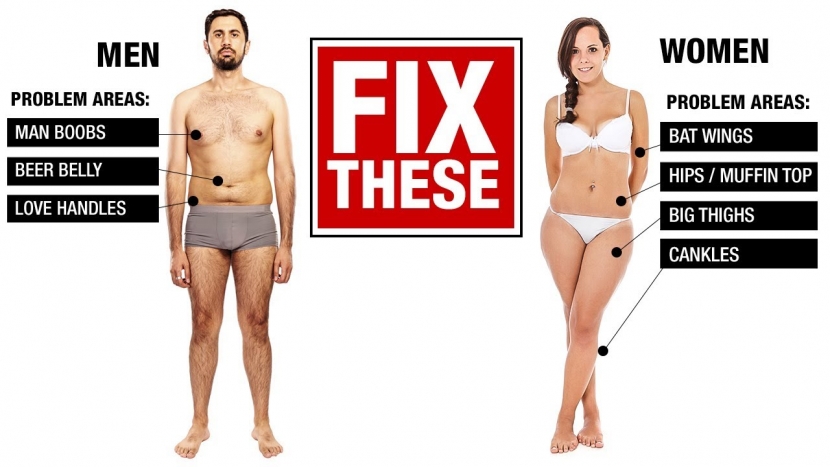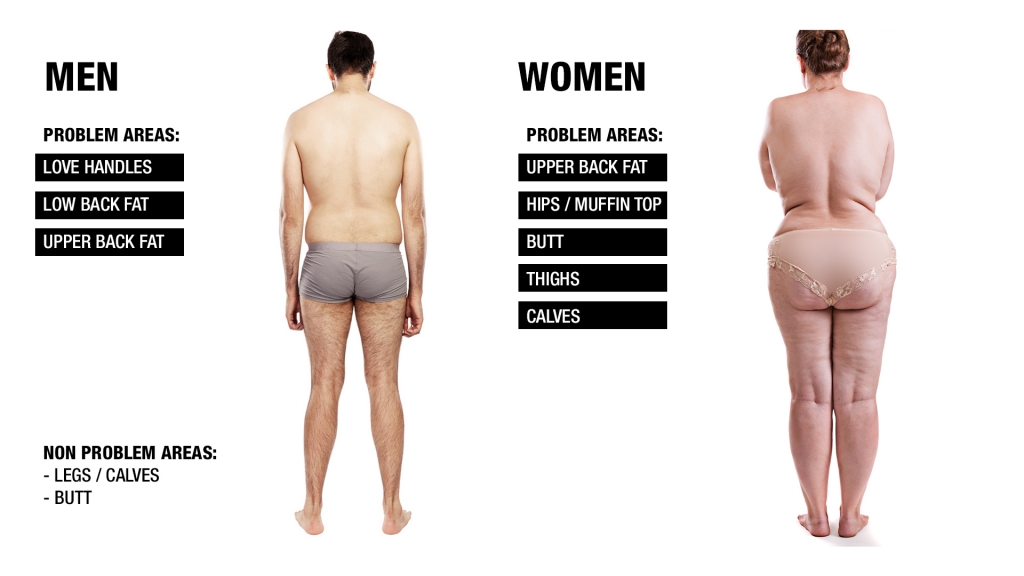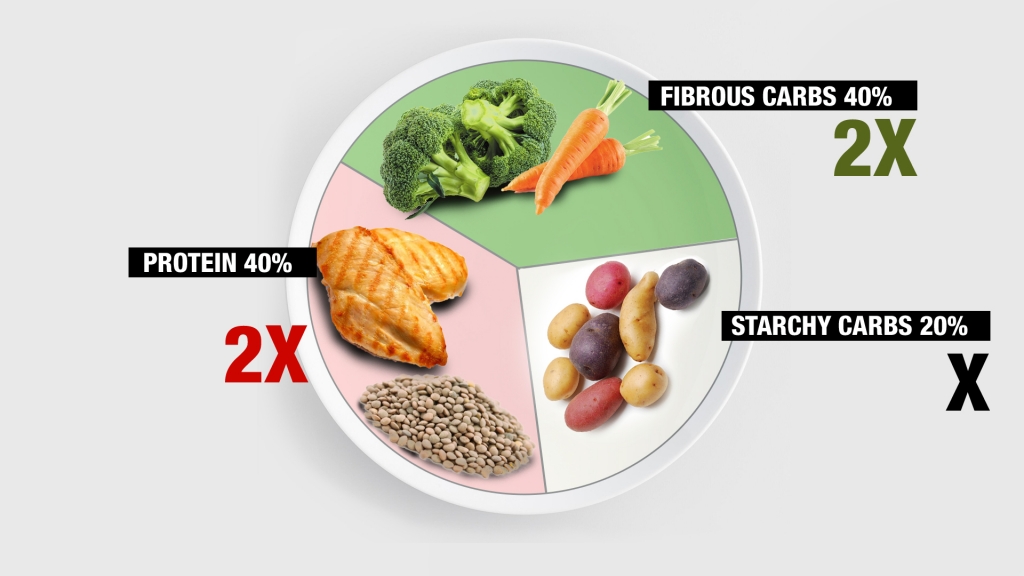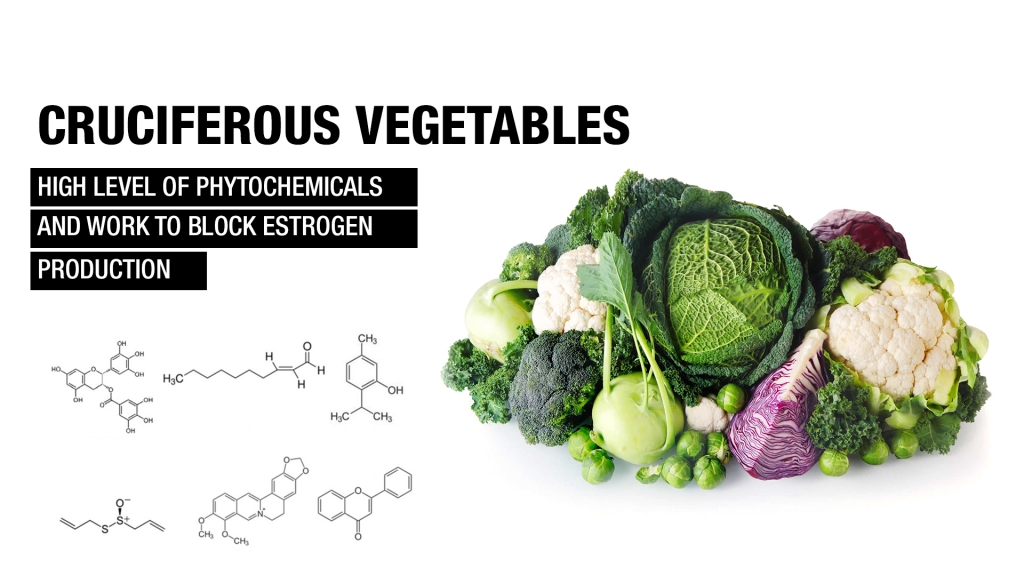How to Lose Fat the Right Way (MEN VS WOMEN!)

We can all see the obvious differences between men and women, including how they store body fat. But they also lose fat differently.
Does this provide a way to change training and eating?
Nature dictates how men and women store fat, but the good news is that by using the right training and nutrition, we can boost fat loss and change body composition in both women and men.
Fat loss strategies differ a little for men versus women when it comes to types of exercise activity. As you’ll see, training can be a more effective strategy for fat loss for women than it is for men.
While nutrition is key for weight loss in both genders, it is the biggest key for men to lose unwanted body fat.
Let’s take a quick look at the differences in fat storage for men vs. women.
Then we’ll go into training strategies to optimize fat loss for each gender.
And finally, we’ll review some simple nutrition strategies that work for everyone regardless of gender. The best part is that they require no counting, weighing or measuring at all!

BODY FAT DEPOSITS IN MEN
When we look at a man and a woman who both have a small amount of excess body fat, we can see the difference in fat distribution.
For men, fat tends to accumulate in the waist and chest, even at lower body fat levels. Man boobs start to develop when men are carrying way too much body fat. The waistline or “love handles” is another area of concern.
Perhaps the most notable trouble spot is the excess belly fat in the mid section, adding waist circumference. A classic example is a protruding rock-hard beer belly.
This is ‘visceral fat’ which occurs inside the abdomen, and it impinges on the internal organs, making it a more dangerous type of fat than subcutaneous fat. Increased storage of excess belly fat in men is often associated with higher risk of heart disease.
Even relatively lean men will store fat in very specific areas of their mid-sections, like their lower belly, upper back, and low back. I have a very low body fat percentage, and I still have remnants of fat in my low back that I will probably never get rid of.
Men tend to not have fat storage in issues in their calves, legs, and arms providing they’re not extremely overweight.

BODY FAT DEPOSITS IN WOMEN
Women tend to store more fat in their lower bodies than men do.
This includes fat deposits in the butt, hips, thighs and sometimes even the calves.
Fat storage appears in the upper body for women as well. Women also usually store more fat in their arms than men do. This is especially true in the case of the triceps area, creating that ’bat wing’ effect.
Excess fat deposits are also common in the upper back around the bra area.
Finally, women also tend to store fat in the mid-section… the famous ‘muffin top.’
What causes the difference in fat storage between men and women?
Let’s dig into the science a little further.
WHAT THE SCIENCE SAYS
You should feel encouraged that there’s an identifiable cause for these differences in fat storage, and it’s the hormonal differences between men and women.
We all carry the male and female hormones testosterone and estrogen. Those ratios are different between men and women, and it’s these ratios that impact what happens with fat storage.
Women have more subcutaneous fat, often driven by the binding of estrogen. Subcutaneous fat located right underneath the skin frequently leads to that pock-marked look of cellulite.
You may even sometimes see cellulite in thin women. While this type of fat is less dangerous than visceral and belly fat it can still be troublesome, and if you have it, you likely want it gone!
How do we fix this problem? Through training and nutrition, with emphasis on nutrition
In the case of men, higher testosterone typically creates more visceral fat, and belly fat stored behind the muscle surrounding the organs. Visceral fat is more androgenic, with more receptors in this adipose tissue that bind to testosterone, which promotes the deposition of this fat.

WOMEN, TRAINING, AND FAT LOSS
Women are likely to see more immediate changes in body fat percentage from training than men, even without changing their diet.
Men can train, train, train, but without getting their nutrition in check, they really won’t see much of a difference in the amount of body fat that they’re carrying. However, because women naturally carry lower levels of lean muscle mass which burns fat even during rest, they respond well to almost any training.
Women should follow a three-pronged training approach for healthy body fat loss:
- Focus the majority of your training on resistance training (weight training workouts)
- Do some low-intensity exercise like steady state cardio for an additional calorie deficit
- Add some high-intensity training like HIIT
STRENGTH TRAINING
The most effective form of exercise for women to lose fat and reverse unwanted weight gain is with strength training, using progressive overload to build muscle mass and increase metabolic rate.
Resistance training workouts will allow women to add muscle mass to their frames, which is not only anabolic, but will also help increase their existing levels of testosterone which aids in fat loss.
Women are often afraid weight lifting workouts will make their legs big. Don’t be afraid. Women don’t produce enough testosterone for that to happen. As long as you’re focusing on nutrition, your legs will get toned through strength training, and lose the body fat that is making them look big now.
AEROBIC EXERCISE
I’m not a fan of steady state cardio, but it does allow you to increase calorie burn to lose some extra body fat.
Sometimes just the act of doing any training at all for some period of time, even walking on a treadmill at a level of incline, provides enough resistance and overload to start to develop some lean muscle mass.
The more muscle you have, the more you can reap its benefits: greater insulin sensitivity, greater glycogen storage capacity, and increased metabolism.
Women definitely need to focus on nutrition as well, even though training will have more of an impact for them than it will for men. The good news is that it’s not necessary for you to obsess over food, count calories or worry about measuring and counting. In the nutrition section, you’ll see that there’s a much easier way!
MEN, TRAINING, AND FAT LOSS
Men are wasting their time doing additional low-intensity aerobic exercise such as walking on a treadmill at a low speed if fat loss is the goal.
There are cardiovascular benefits to cardio exercise if you’re training at a high enough level, and you’ll burn extra calories. But if you want to make a significant difference in the appearance of the fat that you carry, these forms of cardio won’t do it. Don’t waste your time.
Studies have shown that for men to lower their body fat percentage, the focus should almost always be on nutrition.
Since men already have larger amounts of testosterone, and likely carry more muscle mass as a result, they should focus first on getting their nutrition in check. This will help lower their body fat, especially when done in conjunction with a smart training program, which should include weight lifting.
NUTRITION: TIPS THAT WORK FOR FAT LOSS
I said nutrition is the most important factor when it comes to fat loss, and I meant it.
Training is important, but if you had to choose between training and nutrition, nutrition is what both men and women should be focusing on. All. The. Time.
I’d like to give you a structure to follow that doesn’t include things like counting calories or intermittent fasting.
Here’s a very simple nutrition tip that works. Take your plate and divide it visually into 40%, 40%, and 20%. That’s 40% protein, 40% fibrous carbs and 20% starchy carbs. Simple.

Protein intake can be from either plant or animal sources, so it’s OK if you’re following a vegan diet. Find protein-rich foods that you enjoy and that taste good because this is not about depriving yourself.
As you can see, this isn’t a low carb, high protein diet. The majority of the plate is carbohydrates, 40% fibrous and 20% starchy carbs. Fibrous carbs are all the green and colorful vegetables with cellulose which are high-fiber foods.
You’ll notice that we’re not looking to limit starchy carb consumption, especially for athletes. Carb intake is important for fueling performance. My favorites are sweet potatoes and brown rice. These are higher in nutritional value than refined carbs.
When it comes to fats, it’s not necessary to avoid them, just be careful to not overdo them for calorie intake. One of the biggest mistakes I ever made early on in my fitness journey was avoiding fats.
It’s important to realize that fats are very high in calories (9 calories per gram, versus 4 calories per gram for proteins or carbs), and they add up quickly. Many people like to use olive oil which is a healthy fat. That’s great, except that it has 120 calories per tablespoon, so if you put 6 tablespoons on your salad, you just added 720 calories to that salad!
Coconut oil also has nearly 120 calories per tablespoon (about 117 calories per tablespoon). Sometimes a bit of excess healthy fats can put you at risk of weight gain or failing to reach your fat loss goals.
As far as beverages are concerned, water is best. Although there’s debate over exactly how much water you should drink, you need it to survive, and it has no calories at all. Sugary drinks and other calorie-rich drinks like alcoholic beverages add a lot of calories and have very little, if any, nutritional benefit.
NUTRITION: GREAT FOODS FOR FAT LOSS
In addition to the fat loss tips above, you can also try incorporating some of Mother Nature’s secret metabolism boosting food ingredients.
These include foods like ginger, red grapes, mushrooms, oysters, and cruciferous vegetables. Don’t think of any of these as a magical ‘superfood’. However, incorporating all of these things regularly over time can make a difference.
The active compounds in ginger, namely ginger oil, help you boost immunity and reduce stress. Since stress hormone accumulation can increase fat deposition for both men and women, we want to be sure to control our stress levels and exercise recovery.
Studies also show that this will have the ability to increase testosterone levels a little. So, incorporate ginger into your diet.
GINGER

GRAPES
Grapes contain resveratrol, which acts favorably on estrogen, and shifts the focus a little bit away from estrogen-driven fat storage. Studies have shown resveratrol has other health benefits as well, for heart health and reducing inflammation.

MUSHROOMS
Mushrooms are another helpful ingredient that prevents the production of aromatase, which is responsible for converting androgen (e.g. testosterone) to estrogen.
Remember, we’re trying to boost testosterone, so including mushrooms in your diet will be helpful in influencing that transition with your hormones.

OYSTERS
Oysters are a good source of zinc which has testosterone-boosting effects. There’s more zinc per serving of oysters than any other food.

CRUCIFEROUS VEGETABLES
It’s important it is to have cruciferous vegetables like cauliflower and broccoli in your diet. These are high in phytochemicals, which block estrogen production.

So, there’s a comprehensive look at the differences in how men and women store and lose fat. How they store fat depends a lot on hormones, which we can’t do much about,
Remember, there are no diets, no supplements, no calorie counting, no fasting, no gimmicks, or shortcuts to lose weight and gain muscle. Get your nutrition in check and have a smart training plan to allow you to build muscle progressively. As I always say, with a scientific approach to nutrition and training both men and women can achieve their fitness goals.
If you’re looking for a training program that can help you build muscle and lose fat at the same time, I’ve got you covered!
By Jeff Cavaliere MSPT, CSCS

